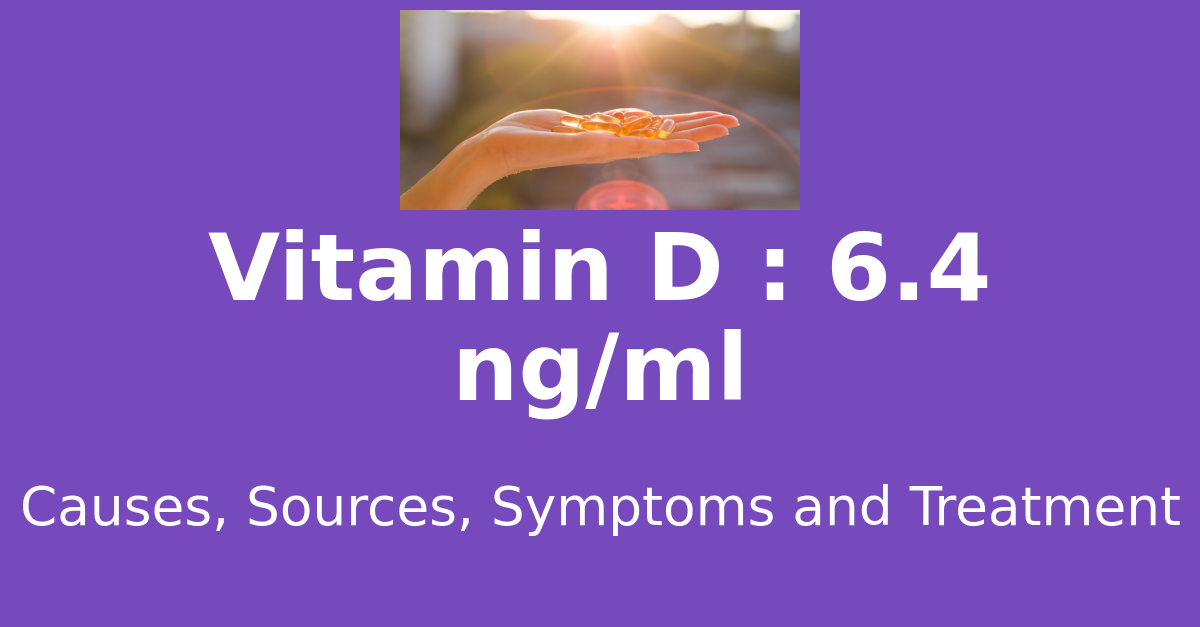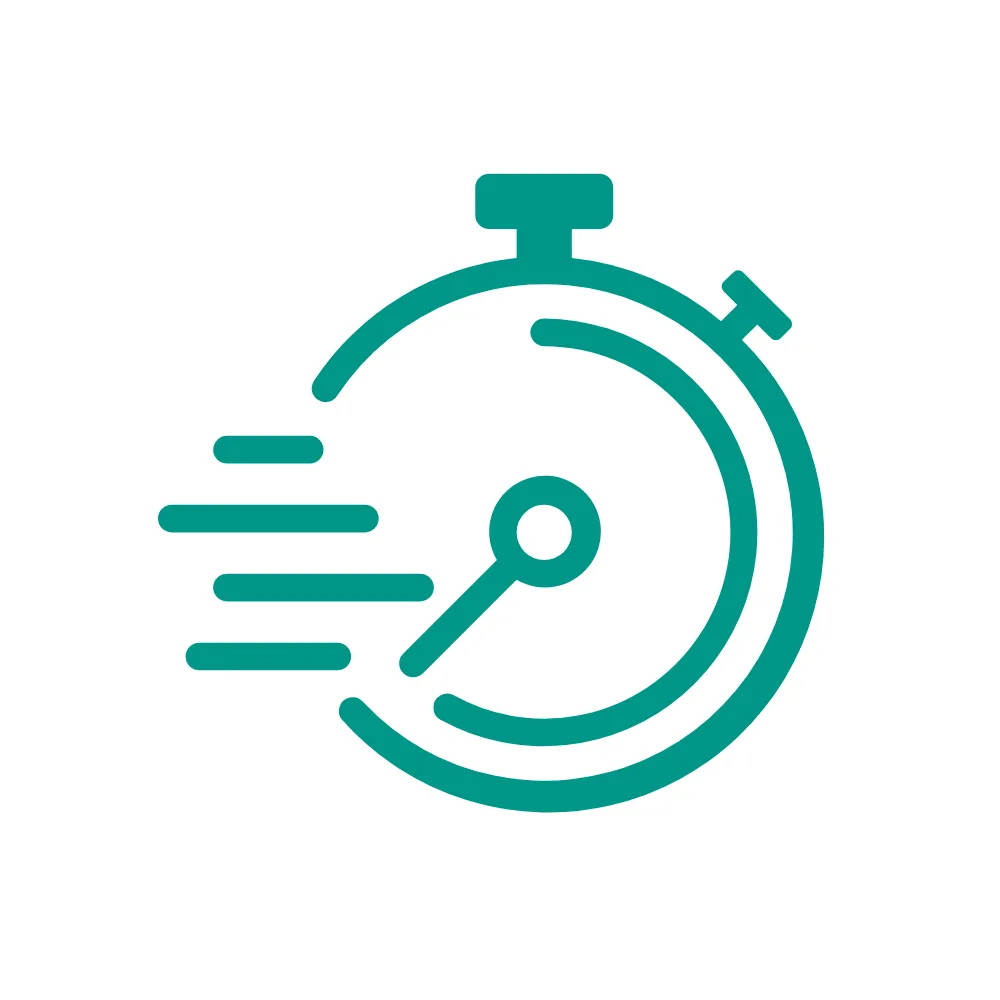
Vitamin D 6.4 ng/ml means : causes, sources, risks, treatment
In this article we discuss what a Vitamin D value of 6.4 ng/ml means, what are its causes and how to calculate your Vitamin D deficiency risk score, and how to improve your Vitamin D as well as a treatment plan and possible risks.Published Date : 2023-08-30T14:56:15.567Z
Updated Date : 2023-08-30T14:56:15.567+00:00
Table of Contents
What does a Vitamin D level of 6.4 mean?
What is my Vitamin D level in SI units, for value of 6.4 in standard units?
Is a Vitamin D value of 6.4 considered low or high?
What are the sources of Vitamin D?
What are the causes of Vitamin D deficiency?
What symptoms will I experience with a Vitamin D of 6.4 ng/ml?
What additional risks do I face with a Vitamin D level of 6.4?
What is my Vitamin D deficiency score and how to calculate it?
What is the treatment plan for a Vitamin D level of 6.4?
What does a Vitamin D level of 6.4 mean?
A vitamin d level of 6.4 is considered to be deficient.
What is my Vitamin D level in SI units, for value of 6.4 in standard units?
In order to convert the value of Vitamin D from ng/ml into the SI Units, we must use a formula of conversion : Vitamin D in SI units (nmol/L) = Vitamin D in ng/ml*2.4961 Based on the given formula, the value of Vitamin D in SI units for a value in ng/ml of 6.4 is 16.0 nmol/L
Is a Vitamin D value of 6.4 considered low or high?
Based on your Vitamin D value of 6.4. you are classified as having a severe Vitamin D deficiency.
Vitamin D Levels
| Category | Level (ng/mL) | Description |
|---|---|---|
| Severe Deficiency | < 10 | Severely low vitamin D levels **You are here** |
| Moderate Deficiency | 10 - 20 | Moderate Vitamin D Deficiency |
| Insufficiency | 20 - 30 | Mild to Insufficient |
| Healthy | 30 - 80 | Normal Vitamin D Levels |
| Toxicity | > 80 | Potentially harmful vitamin D levels |
What are the sources of Vitamin D?
| Food | How it helps with Vitamin D |
|---|---|
| Oysters | Oysters provide Vitamin D and other nutrients, though levels can vary. |
| Canned salmon | Canned salmon, especially with bones, provides a convenient source of Vitamin D. |
| Lamb | Lamb meat contains small amounts of Vitamin D. |
| Almond milk | Some almond milk products are fortified with Vitamin D. |
| Sardines | Sardines are a good source of Vitamin D, especially when consumed with the bones. |
| Salmon skin | Salmon skin contains some Vitamin D, but it's recommended to consume the flesh for better nutrient balance. |
| Tofu | Some tofu products are fortified with Vitamin D, especially those made from soy milk. |
| Fortified plant-based milk | Non-dairy milk alternatives (e.g., almond, soy) are often fortified with Vitamin D. |
| Cod liver oil | A rich source of Vitamin D, often available as a dietary supplement. |
| Fortified orange juice | Certain brands of orange juice are fortified with Vitamin D to increase its nutritional value. |
What are the causes of Vitamin D deficiency?
| Cause | Description |
|---|---|
| Certain hormonal disorders | Hormonal imbalances can influence Vitamin D metabolism and its effects on the body. |
| Inflammatory bowel disease | Conditions like Crohn's disease can impair nutrient absorption, including Vitamin D. |
| Limited outdoor activities | A sedentary lifestyle with minimal outdoor time can result in reduced sunlight exposure. |
| Crohn's disease | An inflammatory bowel disease that can lead to malabsorption and nutrient deficiencies. |
| Cystic fibrosis | Individuals with cystic fibrosis are at a higher risk of Vitamin D deficiency due to malabsorption. |
| Chronic kidney disease | Kidney dysfunction can disrupt the activation of Vitamin D, leading to deficiency. |
| Chronic obstructive pulmonary disease (COPD) | People with COPD may have limited outdoor activities and altered Vitamin D metabolism. |
| Strict vegan or vegetarian diet | Limited intake of animal products, which are sources of Vitamin D, can contribute to deficiency. |
| Older age | As people age, their skin becomes less efficient at converting sunlight into Vitamin D. |
| Multiple sclerosis | People with multiple sclerosis often have lower Vitamin D levels, although the relationship is complex. |
What symptoms will I experience with a Vitamin D of 6.4 ng/ml?
The symptoms of Vitamin D deficiency in children and adults are manifested by rickets and osteomalacia respectively. These conditions may show a variety of symptoms ranging from mild muscle pain, and bone pain to developmental abnormalities and fractures. For a Vitamin D level of 6.4 the symptoms are enlisted in the table below:Vitamin D level 6.4 Symptoms in Children
| Symptom | Description |
|---|---|
| Difficulty Breathing | In severe cases, rickets can cause deformities of the ribcage, leading to difficulty in breathing and increased susceptibility to respiratory infections. |
| Fractures | Due to weakened bones, children with rickets are more prone to fractures even with minor injuries. |
| Bone Deformities | Rickets can lead to bone deformities, such as bowed legs or knock-knees, due to weakened bones unable to support the body's weight properly. |
| Delayed Growth | Children with rickets may experience slowed growth and development compared to their peers. |
| Weak or Soft Bones | Rickets can cause bones to become weak and soft, leading to an increased risk of fractures. |
| Vision Problems | Rickets can affect the eyes, leading to problems such as night blindness and other visual disturbances. |
| Muscle Cramps | Vitamin D deficiency associated with rickets can lead to muscle cramps and spasms. |
| Delayed Walking | Some children with rickets may experience delays in achieving developmental milestones, like walking. |
| Dental Problems | Rickets can affect the development of teeth, leading to dental issues such as delayed eruption and enamel defects. |
| Muscle Weakness | Muscle weakness can result from compromised bone health and nutritional deficiencies associated with rickets. |
Vitamin D level 6.4 Symptoms in Adults
| Symptom | Description |
|---|---|
| Short Stature | In childhood cases, untreated osteomalacia can result in short stature and growth delays. |
| Difficulty Climbing Stairs | Muscle weakness and bone pain can make climbing stairs difficult for those with osteomalacia. |
| Depression | Chronic pain and physical limitations in osteomalacia can contribute to feelings of depression. |
| Fatigue | Generalized fatigue and weakness are common symptoms of osteomalacia. |
| Delayed Healing | Fractures and injuries may take longer to heal due to impaired bone mineralization in osteomalacia. |
| Fractures | Brittle and weak bones due to osteomalacia increase the risk of fractures even with minor injuries. |
| Joint Pain | Osteomalacia-related muscle and bone weakness can result in joint pain and discomfort. |
| Frequent Infections | Impaired bone health can weaken the immune system, leading to an increased susceptibility to infections. |
| Difficulty Standing | Weak bones and muscles can make it challenging to stand for prolonged periods. |
| Muscle Cramps | Deficiencies in bone mineralization and electrolytes can lead to muscle cramps and spasms. |
What additional risks do I face with a Vitamin D level of 6.4?
| Level | Risk |
|---|---|
| Your value is Less Than 25 | Increased risk of fallsBischoff-Ferrari |
| Your value is Less Than 10 | 40% more risk of mortality compared to those with vitamin d above 40Ginde AA |
| Your value is Less Than 8 | More risk of cardiovascular mortality than those with a median vitamin d of 28Dobnig H |
| Your value is Less Than 15 | Two fold higher risk of having high blood pressure as those with Vitamin D above 26Reis JP |
| Your value is Less Than 21 | Increased risk of diabetes, hypertension, obesity and high triglyceride levelsMartins D |
What is my Vitamin D deficiency score and how to calculate it?
Since your value of Vitamin D 6.4 is below the normal limit of 30, you must evaluate the following 4 factors that may be contributing to your deficiency. Based on a study done by Garg et al the following Vitamin D Insufficiency and Deficiency Score can predict and determine your causes of deficiency.
As per the study 4 major factors are invovled in Vitamin D deficiency.
Factors and Descriptions
| Factor | Description |
|---|---|
| Physical Activity | Engaging in regular physical activity can contribute to improved metabolism and Vitamin D levels. |
| Obesity | Obesity, indicated by a body mass index (BMI) of 25 kg/m² or higher, can lead to Vitamin D deficiencies |
| Diet | Dietary intake of at least 100 Grams (gms) of milk/dairy products OR at least 100 gms fish or 1 egg with yolk for four or more days in the last seven days was considered Adequate |
| Daily Sun Exposure | Daily exposure to sunlight is important for the body's synthesis of Vitamin D. Spending at least 1.75 hours in the sun each day can help maintain Vitamin D levels, which is essential for bone health and immune function. |
Insufficiency Score for Vitamin D : 6.4
- You get less than 1.75 hours of sunlight per day
- AND
- Insufficient Dietary Intake
- AND
- Obesity
- AND
- Insufficient Exercise
- Score : Your Vitamin D Insufficiency Score ranges between 14 - 18.
What is the treatment plan for a Vitamin D level of 6.4?
Vitamin D supplmentation is the only way to correct for deficiencies. The tables below list the dosages of Vitamin D supplements recommeded for different age groups, depending on the level of the Vitamin D. Since your value of Vitamin D is 6.4 the relevant supplement dosages are indicated below.Pawel Pludowski
Recommended Daily Dosing for Vitamin D in cases where the Vitamin D Level is < 10 ng/dl
| Age Group | Vitamin D Intake Per Day | Duration |
|---|---|---|
| Infants < 1 month | 1000 IU/d | 3 months |
| Infants 1–12 months | 2000 IU/d | 3 months |
| Children 1–11 yrs. | 5008 IU/d**(Represents a value in the range of 3000 - 6000, must be adjusted as per patient.) | 3 months |
| Children 11–18 yrs. | 6000 IU/d | 3 months |
| Adults | 6000 IU/d | 3 months |

Reviewed By - Dr.Bhargav Raut
Dr.Bhargav Raut is a qualified Pathologist, with over 5 years of experience in the field
Kindly note that any mention of products, doctors or hospitals in any of our blogs/content is purely for informational purposes and does not imply affiliation or endorsement.
Dr.Bhargav Raut offers Online Consultation for your lab reports. If you are confused about your reports, or want an opinion for a health concern, click the button below. He charges USD 14.99/- to go over your case. Dr.Raut is board certified (India) and has several years of experience in interpreting lab reports
Please attach your lab reports in the email with a short description of your illness/problem.
Email us at support@pathofast.com or click the button below
